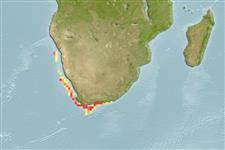(كوسه ها و سپرماهيان) (sharks and rays) >
Torpediniformes (Electric rays) >
Torpedinidae (Electric rays)
Etymology: cowleyi: The species is named after Paul Cowley, South African Institute for Aquatic Biodiversity, in recognition of his contributions to the study of fishes in southern Africa (Ref. 100734).
Environment: milieu / climate zone / depth range / distribution range
بوم شناسي
دريايي موجوداتی که در محدوده وسیعی از آبهای آزاد از نزدیک بستر و یا روی کف بستر، در قسمت های میان آبی تا سطح آب و در برخی گونه ها با قابلیت پرواز، زندگی و تغذیه می کنند.; تغييرات عمق 110 - 457 m (Ref. 100734). Temperate; 22°S - 37°S, 12°E - 28°E (Ref. 114953)
Southeast Atlantic: around southern Africa, from Walvis Bay, Namibia to Algoa Bay, Eastern Cape, South Africa (Ref. 100734).
Length at first maturity / Size / Weight / سن
Maturity: Lm ?, range 101 - ? cm
Max length : 68.0 cm TL جنس نر / بدون خواص جنسي; (Ref. 100734); 113.3 cm TL (female)
توصيف مختصر
ريخت شناسي | ريخت ستجي بوسيله انداره گيري
Diagnosis: This medium-sized torpedo ray species has a uniform shiny black to dark gray live dorsal color, and is distinguished from its most similar congeners Tetronarce nobiliana and T. puelcha by the following combination of characters: shorter spiracular length, 1.5-1.6% of total length vs. 2.6-2.8% in T. nobiliana and 2.4-3.1% in T. puelcha; a proportionally greater head length as measured between snout margin and fifth gill openings, 30.5-31.2% of total length vs. 24.7-25.8% in T. nobiliana and 26.8% in adult male T. puelcha; and a proportionally greater preoral snout length, 8.9-9.3% of total length vs. 7.4-7.6% in T. nobiliana and 6.5-8.4% in T. puelcha (Ref. 100734). It is further distinguished from T. nobiliana by its more circular anterior disc shape vs. relatively straight; fewer tooth rows, 32/28 vs. 38/38 in T. nobiliana from the North Sea and up to 53/52 in T. nobiliana from the Mediterranean; greater mouth width, 1.5-1.7 times as great as interorbital width vs. 0.5-0.6 times interorbital width; smaller distance between second dorsal and caudal fins, 3.5-4.9% vs. 6.6-6.8%; and greater clasper length in mature individuals, extending nearly to lower caudal fin origin vs. clasper extends only two-thirds the distance between second dorsal and caudal fins (Ref. 100734).
This species is mostly found along the outer continental shelf and upper slope near the bottom, but also well off it and at bottom depths of 110-457 m (Ref. 100734). Females mature by at least 100.5 cm total length and males at about 58.2 cm total length (Ref. 100734); born before 19 cm TL (Ref. 114953). Neonates reported to have been collected during pelagic plankton tows on the edge of the outer continental shelf southwest of Cape Town (Ref. 100734). The limited capture of this electric ray in bottom trawls is suspected to be not indicative of its abundance in the area, but rather by its ability to move well off the bottom while foraging for fish and other large prey; diet consists mainly of large bottom and pelagic bony fishes and small sharks (Ref. 100734).
Life cycle and mating behavior
بلوغ | تولید مثل | تخم ریزی | تخم ها | Fecundity | توزاد ( لارو)
Ebert, D.A., D.L. Haas and M.R. De Carvalho, 2015. Tetronarce cowleyi, sp. nov., a new species of electric ray from southern Africa (Chondrichthyes: Torpediniformes: Torpedinidae). Zootaxa 3936(2):237-250. (Ref. 100734)
وضعيت در فهرست قرمز IUCN (Ref. 130435)
خطر برای انسان ها
Harmless
استفاده انسانی
ماهي گيري – شيلات:
اطلاعات بيشتر
اسامي عاممترادفسوخت و سازشکارچیانسم شناسي بوم زيستيتولید مثلبلوغتخم ریزیSpawning aggregationFecundityتخم هانمو تخم
Age/Sizeرشدطول - وزنطول - طولنوسانات طولیريخت ستجي بوسيله انداره گيريريخت شناسيتوزاد ( لارو)پويايي لارويبازسازیفراوانيBRUVS
مراجعآبزي پرورينمايه آبزي پرورينژادهاژنتيكElectrophoresesوارثبيماري هافرآوریNutrientsMass conversion
همكارانعکس هاStamps, Coins Misc.صداهاسيگواتراسرعتنوع شناگریمنطقه آبششيOtolithsمغزهابینایی
ابزارها
گزارش های ويژه
بارگيری XML
منابع اينترنتي
Estimates based on models
Phylogenetic diversity index (Ref.
82804): PD
50 = 0.5001 [Uniqueness, from 0.5 = low to 2.0 = high].
Bayesian length-weight: a=0.01479 (0.00659 - 0.03318), b=2.97 (2.78 - 3.16), in cm total length, based on LWR estimates for this (Sub)family-body shape (Ref.
93245).
Trophic level (Ref.
69278): 4.4 ±0.6 se; based on size and trophs of closest relatives
جهندگی (Ref.
120179): خیلی آهسته, كمينه زمان لازم براي دو برابر شدن جمعيت بيش از 14 سال (Preliminary K or Fecundity.).
Fishing Vulnerability (Ref.
59153): High to very high vulnerability (68 of 100).
